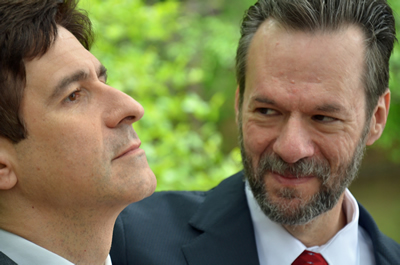Surprise! Upon leaving my home for Duke Gardens’ Kirby Horton Hall, I spied two inconspicuous white blooms in the garden — re-blooming iris that were due in November. This was surely an auspicious beginning to an evening of musical delight — the second of two summer chamber music programs of Duke Performances’ Music in the Gardens, I had been looking forward to French piano trios but, due to unforeseen circumstances*, the entire program was scrapped. The slated pre-concert program by Matthew Kan, violin, and Kathleen Wilkin. piano, unexpectedly took center stage in their Duke University debut. Eric Pritchard, first violinist for the Ciompi Quartet, and his partner, R. Larry Todd, piano — he is Arts and Sciences Professor of Music — performed on the second half. As it turned out, the German-heavy program was quite wonderful.
Matthew Kan bravely opened with J.S. Bach’s great monument, the Chaconne from the Partita No. 2 in D minor, S.1004, a piece that separates men from the boys. After a few measures of the jitters, and relying on a splendid vibrato, he settled into a comfortable pace. His tone was deep and warm, the bow, secure, and the treacherous passagework, firmly under his fingers. Kan’s was a fine performance, clearly mastered. He was joined by Kathleen Wilkin for the rest of the first half, devoted to recital favorites: Elgar’s “Salut d’Amour,” Op. 12, “Après un rêve,” Op. 7, No. 1, by Fauré, arr. Joshua Bell, and Kroll’s “Banjo and Fiddle.” Kan nailed these as well — all by memory; and Kathleen Wilkin did a splendid job. The audience gave them high marks with thunderous applause.
Eric Pritchard and R. Larry Todd performed two of the three Brahms violin sonatas, Op. 78 (1879), and Op. 108 (1888). Brahms was considered old-fashioned by Wagner and Liszt, but these compositions have, nevertheless, met the test of time. The G major Sonata, penned just one year after the celebrated Violin Concerto in D major (1878), is a favorite of both players and listeners. Beautiful melodies linger in one’s musical memory and, according to Peter Lamb’s liner notes (1987, CHAN 8517, Chandos Records Ltd.), the “beguiling rhythm of the Viennese waltz haunts the music from its very beginning.“ The contrasting third sonata in E-flat is stormy and passionate — an ideal pairing. And because he was a superb writer for the piano, Brahms created an equal partnership, not unlike Beethoven, in his sonatas for piano and violin.
Pritchard and Todd, a compatible duo, played with passion and conviction. Pritchard made the most out of every expressive marking — the abrupt tempo and dynamic changes. Technically demanding double stops and widely spaced leaps in Sonata No. 3 were all beautifully in tune, an admirable feat under the circumstances. Todd, equally adept, never missed a beat (or better yet, off-beat). Loaded with syncopation and phrasing over the bar-line, the final movement, marked Presto agitato, calls for precision with lightning speed at every turn. Pritchard played with fire — his finesse with the bow exquisite. They make an exceptional duo. I hope we get to hear them play together again soon.
With daylight savings time, the night was still young and I felt like skipping.
*After a moment of disappointment and concern for the cellist, Fred Raimi, the German main course felt rich and nourishing. I’m certain the audience will join me in wishing Mr. Raimi a speedy recovery and extending great thanks to the evening’s stand-in performers. Matthew Kan is a third year student in the M.D., Ph.D. program at Duke University, and Kathleen Wilkin will begin her nursing studies at Duke in the fall. They are both active members of the Duke University chamber music community.











